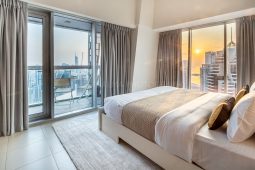Barely a year old, Bellazul restaurant and bar on Blandford Street is a great new addition to the many eateries in the Marylebone neighbourhood.
Decor is warm with a calming mix of blue walls, white and light wood, made ever so cosy by the hues of lantern lights. There are traditional tables, and some high tables on the ground floor and on the lower ground there is a larger restaurant in the same colour scheme. Outside, there are some alfresco tables for those long summer days and evenings.
We got there early one heady spring evening, a tad too early, so we propped up the bar for a glass of Ferrari Maximum Blanc de Blanc, a lively Italian sparkling wine, and a flavoursome Margarita cocktail expertly made by Lazarus, the manager.
Soon after, we made our way to our table and were served a basket full of various homemade breads, olive oil and olives, which we nibbled on while perusing a menu.
We chose the Tzatziki and dipped pitta into its soft creaminess, tartare di Tonno, a tangy and juicy bites of soft yellowfin tuna tartare on avocado, flavoured with lime, and a mushroom arancini, a set of four golden brown balls, which had super crispy coatings with gorgeous mozzarella and bechamel sauce inside.
My main course was the flavoursome grilled chicken Paillard – the chicken is pounded flat and flashifried in a sauté pan – topped with tomatoes, rocket and shaved parmesan. This is a classic Italian dish perfect for spring or summertime dining.

Chicken Paillard
My partner enjoyed a soft and juicy beef fillet with a green peppercorn sauce and veal jus paired with a glass of a tasty ruby red Montepulciano d’Abruzzo Gran Sasso from Italy offering blueberry and subtle herb flavours.

beef fillet with s green peppercorn sauce and veal jus
The evening was drawing to an end, and we had enjoyed some amazing food. Yet our sweet tooth was demanding, and so we decided to share a tiramisu. Even though we had eaten well, our spoons still sank greedily into this chocolatey, creamy dessert until it had disappeared from the plate.
Verdict: Bellazul Restaurant and Bar offers fine but casual dining in a convivial environment with service that was friendly and attentive. Bellazul is an ideal choice for friends or families getting together to dine and natter in a cosy and friendly environment.
Bellazul Meditteranean Restaurant and Bar
43 Blandford St, W1U 7HF
The post Bellazul Retstaurant review, Blandford Street, Marylebone, London appeared first on The Travel Magazine.













